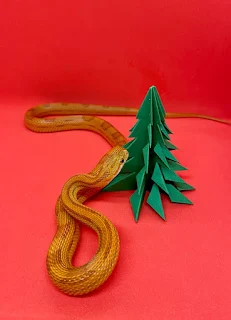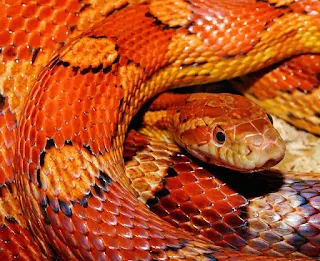The Colorful Corn Snake: An Intriguing Guide to the World of Reptiles
Regarding reptiles, few creatures, like the corn snake (Pantherophis guttatus), capture the imagination.
With its vibrant colors, docile nature, and manageable size, the corn snake has become a beloved choice among reptile enthusiasts and pet owners.
In this article, we'll explore the world of corn snakes, their characteristics, their care requirements, and why they make such fantastic companions.
The Origin of the Corn Snake:
Native to North America, particularly the southeastern United States, the corn snake has a rich history intertwined with human civilization.
Early settlers encountered these snakes near corn cribs, where they hunted rodents attracted to the grain, hence the name "corn snake."
Despite their association with corn, these snakes are crucial in controlling rodent populations, making them valuable agricultural allies.
Appearance:
One of the most striking features of the corn snake is its vibrant coloration.
While wild corn snakes typically display a pattern of red, orange, and brown blotches against a background of cream or gray, captive breeding has produced an array of stunning morphs, including albino, snow, and lavender variations.
These diverse color patterns have made corn snakes popular among breeders and collectors seeking unique specimens.
Size and Lifespan:
Corn snakes are smaller than other constrictor species and usually grow 3 to 5 feet long.
Their slender bodies and smooth scales allow them to move gracefully through their environment.
Corn snakes can live for 15 to 20 years with proper care, making them long-term companions for dedicated owners.
Temperament:
Known for their docile disposition, corn snakes are an excellent choice for novice reptile enthusiasts.
They are generally non-aggressive and tolerate handling well, making them ideal pets for children and adults.
However, handling them gently and ensuring their comfort and well-being is essential.
Habitat and Enclosure:
You must provide a suitable habitat to ensure your corn snake's health and happiness.
This includes a spacious enclosure with adequate ventilation, heating, and hiding spots. Substrate options such as aspen shavings or reptile carpets provide a comfortable surface for your snake to burrow and explore.
A secure lid is also necessary to prevent escapes, as corn snakes are skilled climbers.
Feeding and Nutrition:
As carnivores, corn snakes thrive on a diet of appropriately sized rodents, such as mice or rats.
Young snakes should be fed smaller prey items, gradually increasing in size as they grow.
A varied diet is essential to ensure nutritional balance and regular feeding schedules help establish healthy eating habits.
Always ensure that prey items are appropriately thawed and warmed to room temperature before offering them to your snake.
Health and Wellness:
Maintaining optimal conditions in your corn snake's enclosure prevents health issues such as respiratory infections and scale rot.
Regularly monitoring temperature and humidity levels and routine cleaning help create a clean and hygienic environment.
Additionally, annual check-ups with a qualified reptile veterinarian can help detect and address potential health concerns early on.
Breeding and Reproduction:
Understanding corn snake reproductive biology is essential for those interested in breeding them. Corn snakes typically reach sexual maturity between 18 months and three years, depending on size and health.
Breeding season usually occurs in the spring, with females laying clutches of eggs approximately 30 days after mating. Proper incubation conditions are necessary for the eggs to hatch successfully, with hatchlings emerging after approximately 60 days.
Conclusion:
Few creatures captivate enthusiasts in reptiles quite like the corn snake. With its stunning coloration, gentle demeanor, and manageable care requirements, the corn snake has earned its place as a cherished companion in the world of exotic pets.
Whether you're a seasoned reptile enthusiast or a curious beginner, welcoming a corn snake into your home will surely bring joy, wonder, and a deeper appreciation for the beauty of nature.



Comments
Post a Comment